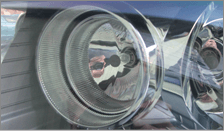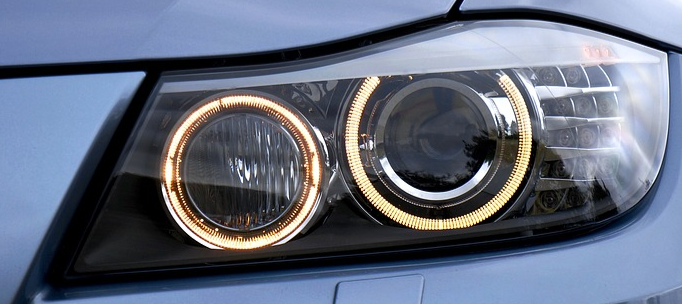
Say for example the new Ferraris 458 have ugly headlights my guess just so to take advantage of better 'projection' in fog etc. Besides, the worst fog I've ever driven in was in Virginia, which I believe is the Piedmont range, and the fog there is ridiculous, but I cut through that just fine with my old halogen equipped car. I don't know if it's the color of the light, or that the light was in such a focused beam, but the light was the difference, not the fog. This time, I had a car with HID projectors. There's no way that after a decade of doing this exact trip, all of a sudden today the fog was worse than it's ever been. I could only see the lines immediately in front of the car and I couldn't see the road signs until they were passing me. This is nothing new for me, this is how I always drive to NYC, and it's always foggy here - however this was my first time experiencing this in my new car equipped with HID projectors. Last Wednesday night (2/16-2/17) I spent 2.5 hours driving through dense fog in the Catskills overnight.

Its pattern is more concentrated and is more pencil beam like which prevents blinding of other drivers.It's interesting you say your HID's are better for inclement weather. The light output does not have intense or weak spots. The field of vision is wide enough, but at the same time, the light pattern has intense and weak spots and the low beam cut off is blurred which may cause the blinding of oncoming traffic.Īs for the projectors, this type of the headlight housing has complicated constructions, comparatively to reflectors. The reflectors have pretty simple design, which allows the light to be scattered evenly. This produces less visual contrast when switching between modes and is less stressful to the driver’s eyes.Īt the end we would like to sum up the info about these types of headlight housings. Using the same bulb for both beams (high and low) permits both modes to have the same light color. In this case the amount of reflection dictates the light intensity and pattern. In the low-beam mode the bulb is lowered in the reflector housing. The bulb can be physically raised in the reflector housing to produce the high-beam output. The other possible way for the projector to perform for high and low beams is change of the bulb position. It is a sort of motor within the headlight assembly that raises and lowers the shield. You are able to switch from the low to high beams due to the movable metal shield which is controlled with solenoid. They perform for the high and low beam taking single beam bulb. Nowadays many automotive sellers offer so called dual beam projectors. The high beam projectors come without the light barrier, so that the light is concentrated when it goes through the lens. The cutoff shield keeps the light from being projected out and up. It serves as a light barrier so that the light is concentrated out and down. The noticeable thing about the projector is the low beam cutoff line that is projected when the lights are switched on. The lens straightens out the path of the light, as it directs every beam in the same direction.
#PROJECTOR VS REFLECTOR HEADLIGHT DRIVERS#
Drivers get better light output with this type of the housing because the light is more controlled. The projector headlight refocuses the reflected light and directs it through a concave lens. They have elliptical reflector, lens, light source and cutoff shield (low beam projectors). Now let’s move on to the projector headlights. The reflector dissipates the light that is available evenly, but not all beams are directed properly and can be reflected too far up or down and be not visible to the driver. This type of the headlight housing involves a lot of wasted light.
#PROJECTOR VS REFLECTOR HEADLIGHT DRIVER#
The reflectors allow the driver to see clearly when it is dark, but on the other hand, they present a hazard for oncoming traffic. This allows the light being emitted from the small bulb to be spread out in front of the vehicle. It is distributed in many different angles. The light reflects from the surface directly outwards in one direction. The design of the reflector is pretty simple: it consists of a light source (headlight bulb) that is situated in the middle of the reflector cup. Inside the housing there are openings where the bulbs are inserted and locked into place. They are used to prevent the moisture from entering the headlight assembly and increase the intensity of the headlight beam. Most of them come with plastic lenses, but there may be exceptions. They come with bulbs that are filled with mixture of the inert gas or Xenon gas. We will start with the reflector type of the headlights.


Today we would like to tell you about reflector and projector headlights. We’ve been talking about the sealed beam type of the headlight housing in one of our articles. It is important to figure out which type of the headlight housing is installed to your vehicle, before upgrading the headlights.


 0 kommentar(er)
0 kommentar(er)
